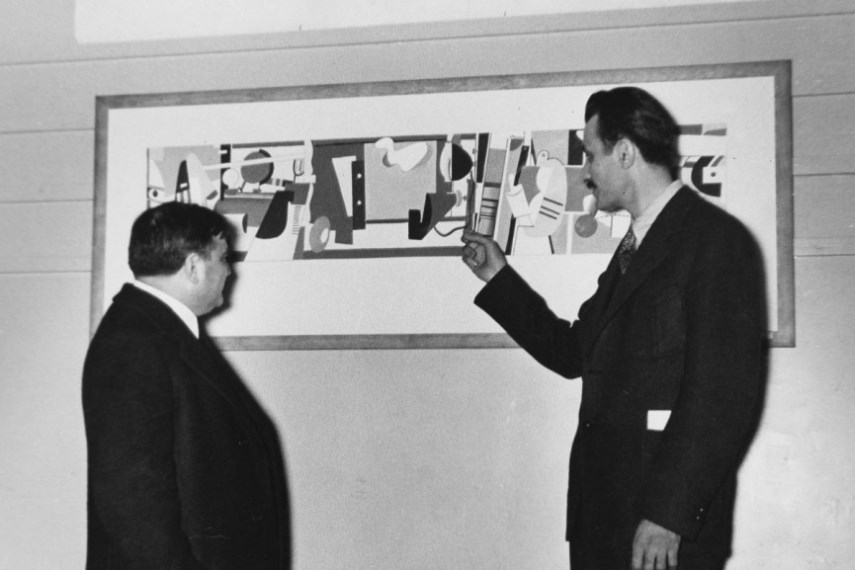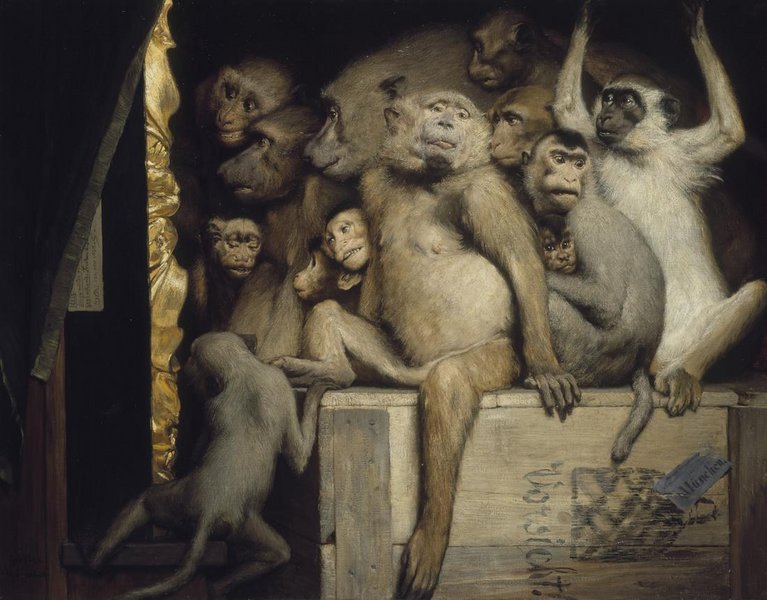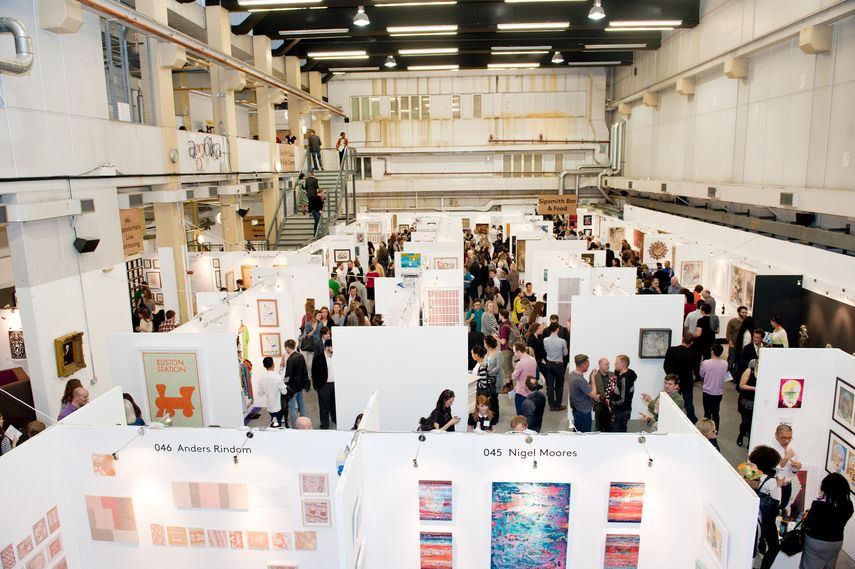Art Criticism Is the Discussion or Evaluation of Visual Art
What is the purpose of art criticism? Practise art critics accept a point anymore? Can they contribute annihilation to the evolution of art? Harsh words, descriptive and critical analysis of pieces of art had long been an integral office of the fine art earth. Art criticism likely originated with the origins of art itself, every bit evidenced past texts institute in the works of Plato, Vitruvius or St. Augustine among others. It tin can be broadly defined every bit a give-and-take and interpretation of art and its value, in the pursuit of a rational basis for art appreciation. In 1932, the French poet and philosopher Paul Valéry defined art criticism equally "a form of literature which condenses or amplified, emphasizes or arranges or attempts to bring into harmony all the ideas that come up to the mind when information technology is confronted past artistic phenomena", with a domain extending "from metaphysics to invective".[1] Interpretative analysis and aesthetical judgments dominated the discourse of fine art criticism for a long flow of time, and art criticism has beenan inevitable part of contemporary art dynamics. The criticism has an of import role in developing and deepening the work of artists, but also in helping viewers perceive, and translate works of art. Yet, in 2005, the fine art critic Dave Hickey stated: "Criticism, at its most serious, tries to channel change, and when nothing is changing, when no one is dissenting, who needs criticism?" His vocalisation joins an ongoing discussion about a crisis in contemporary art criticism.

The Crisis of Art Criticism
For a long fourth dimension, art criticism has been perceived as a course of privileged consciousness that provided an insight into the art that required a special eye for it. Art critics served a regulatory, introspective and proscriptive function for the circulation and reception of art, and artists oftentimes saw their opinions equally useful, insightful, or instructive. In this style, art practice and art criticism are supposed to be in a dialectical human relationship – to complement each other. In his 2003 book What Happened to Art Criticism?, the art historian James Elkins contemplated about its turn down: "In worldwide crisis … dissolving into the background clutter of ephemeral cultural crunch … [art criticism is] dying … massively produced, and massively ignored."[two] Many experts have proclaimed an end to fine art criticism. They argue that, in the last ii decades, art criticism has become ho-hum, unprofessional, and that it has lost its purpose. Many claim that art critics accept become PR agents for contemporary artists, galleries, and the art marketplace, becoming an integral element of the contemporary fine art machinery whose main aim is to brand money. More than significantly, the support for criticality and critical thinking appears dismal in the wider civilization, with a fearful caricature of criticism as the meddling antagonists. Rather than a crisis in criticism, we are currently suffering a crisis of relative values that could be treated with criticism. Without criticism, the but measure out of value in art becomes coin – a measure both fickle and stultifying.

Art Values or Art Marketplace Values
The contemporary art market is mainly about the breeding of coin, not the fertility of art. Thus, commercially high-priced works of art exist to increase the power of money to fertilize itself, non the value of art. Money has no value in itself, it is valuable for what one can substitution it for. Notwithstanding, in the capitalist society, it presents itself as the quintessence of value. With the commercial value of fine art usurping its spiritual value, art's aesthetic, cognitive, emotional, moral and other values of the dialectical varieties of critical consciousness has been subsumed by the value of money. One time it is exhibited and sold, every artwork becomes the product intended to beconsummated simply like whatever other mass-produced object. Every bitWalter Benjamin pointed out, art and culture became co-opted and intended to adapt capitalist interests where conditions of mass product and reproduction of fine art strip it of its function every bit an individual unit. Information technology seems that the art itself has becomea commodity to be bought and sold. Just similar any other enterprise, art has been absorbed past money, and it is the market rather than the critics that decides who are the outstanding artists of the age. In this light, the market is substituted for criticism as the simply means by which a work of fine art is evaluated. When hundreds of millions of dollars have been invested in glory artists such as Damien Hirst or Jeff Koons, it makes petty difference if a critic gives them a bad review. A few years agone, the art critic Dore Ashton wrote that "if art criticism is hostage to the market, and if the destiny of an artist'southward work is to be evaluated on an eternal abacus, something vital has been lost—that is, good conversation among artists and their viewers."[three] This state of affairs of artists being rated but by price results from a devaluation of criticism. If criticism is devalued, artists and curators have no other option in the electric current crisis of relative values simply to heed the market's siren song. Art criticism is important considering information technology creates a place for a work of art to mean, irrelevant of market forces.

A Work of Art Within a Public Discourse
As the art critic David Levi Strauss argues, fine art "needs something exterior of itself as a place of reflection, discernment, and connexion with the larger world".[4] One of the problems central to criticism should be how we brand and sympathise the connection to the real, to the social. Fine art speaks directly to all of us and piques our intuitive critical sensibilities. We're entitled to hold both informed and uninformed opinions, since once the art is out in the world, it belongs equally to anybody. In order to engage, art needs criticism. Grounded in the art object, art criticism provides political and social assay, history, theory, and storytelling. Art criticism engages the world through a work of fine art. Even art reviews that seem to disparage the quality of an artwork are an attempt to extrapolate a piece of work of fine art'southward implication and relation to the larger world. A review that argues that a particular piece of work of art does not adequately or finer bear relation or significance to society, ofttimes dubbed equally "negative", is positive in that elucidates those shortcomings both for the viewer and the artist. In his 1983 essay The Production of the World, the art critic John Berger argued that "reality is not a given: information technology has to be continually sought out, held - I am tempted to say salvaged".[v] Arguing that reality was controlled by mainstream culture and those in power, he believed that skilful fine art brought reality back into focus, and in that sense could be revolutionary. For him, the chore of an art critic was to dribble and sympathize how and why an artist accomplished this, and why their work resonates.

What Is The Purpose of Fine art Criticism?
In terms of criticism's function in connecting a piece of work of fine art to public discourse, there is always a need for more and more than varied perspectives on this relationship. Thus, the art world always needs more art critics. With the ascent of creative industries, the work of art is often treated equally a creative phenomenon rather than the starting point of critical dialogue.[5] The creativity is frequently celebrated as an end in itself, rather than examining the conversations that are inspired by interactions with artworks, and which exist inside artworks. The attitude that implicitly suggests that critical friction is a negative force on forward progress is a rejection of one of the very intentions and consequences of the creative practice. As Baudelaire argued, "information technology is from the womb of fine art that criticism was born". The development of art requires more than and more than academic theory so that the criticism must become an indispensable function of the theoretical system of fine art.
In the vast volume and range of art that we're fed in a culture obsessed with galleries and a staggering book of mediocre art, the critic's chore is to place what is adept and honestly denounce the bad. The evaluation of works of art and the feedback to the creative cosmos can aid artists to sum up their experience of cosmos and constantly improve themselves. While in the past fine art criticism's principal focus was quality control, today, a practiced art critic must besides be mindful of educating the public, promoting discussion and persuading the audience to appoint in the art, good or bad, and crusade them to remember for themselves. There is a certain ethos to practicing art criticism, and Michael Foucault has described information technology all-time:
"A critique is not a matter of saying that things are non right as they are. It is a matter of pointing out on what kinds of assumptions, what kinds of familiar, unchallenged, unconsidered modes of thought the practices that nosotros accept rest…Criticism is a thing of flushing out that thought and trying to change information technology: to show that things are not as self-evident as one believed, to see what is accustomed as self-evident will no longer exist accepted as such. Practicing criticism is a matter of making facile gestures difficult."
References:
- Levi Strauss, D. (2012) From Metaphysics To Invective: Art Criticism Every bit If Information technology Still Matters . The Brooklyn Rail
- Elkins, J. What Happened to Fine art Criticism? Prickly Prototype Press, 2003
- Ashton, D. (2008) Does Invidiousness Become With The Territory? The Brooklyn Rails
- Levi Strauss, D.Ibid
- Berger, J. (1983) The Production of the World
- Simek, P. (2013) What Is Fine art Criticism, And Why Do We Need Information technology? D Mag
- Foucault, M. Practicing Criticism or Is it really important to recall?" May xxx-31, 1981. Didier Eribon interview. In Lawrence Kritzman, Foucault, Politics, Philosophy, Culture. New York and London: Routledge, 1988. p. 155.
Featured images: Image via Jrm Llvr'south Flickrstream
Source: https://www.widewalls.ch/magazine/what-is-the-purpose-of-art-criticism
Post a Comment for "Art Criticism Is the Discussion or Evaluation of Visual Art"